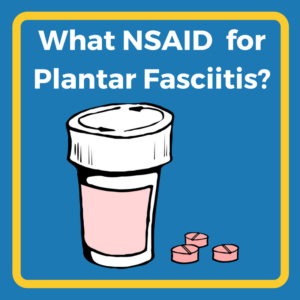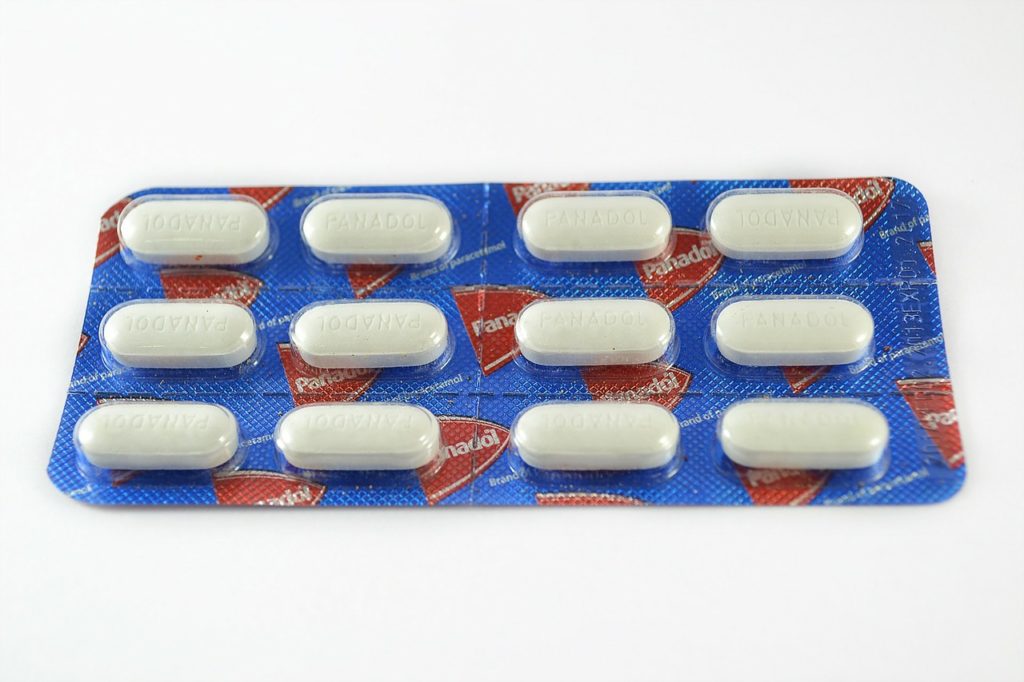By Noelle Ihli, medically reviewed by Dr. Kimberly Langdon, M.D.
 Over-the-counter NSAIDs, or “nonsteroidal anti-inflammatory drugs,” can be an effective way to calm redness, swelling, and pain from plantar fasciitis–particularly if symptoms have been present for less than 6-8 weeks.
Over-the-counter NSAIDs, or “nonsteroidal anti-inflammatory drugs,” can be an effective way to calm redness, swelling, and pain from plantar fasciitis–particularly if symptoms have been present for less than 6-8 weeks.
But are all over-the-counter NSAIDs alike? Which one is best for treating heel pain and plantar fasciitis? And what other treatments should you use in tandem with NSAIDs to heal plantar fasciitis quickly and effectively?
We have your answers!
Are All NSAIDS The Same?
While all NSAIDs reduce swelling, redness, pain, and inflammation, you should be aware of some key differences between popular over-the-counter NSAIDs that you should be aware of. Each type of NSAID will differ in potency, onset time, how long it remains in the body, and how well it blocks prostaglandins (instrumental in causing inflammation).
Ibuprofen (Advil, Motrin)
Ibuprofen is the most common and popularly used over-the-counter NSAID. This drug moderately blocks prostaglandins and has a low risk of GI-tract bleeding and irritation of the stomach lining when used in moderate doses, usually 600 mg every 6 hours.
Naproxen (Aleve)
Naproxen is another popular over-the-counter NSAID that moderately blocks prostaglandins. Like ibuprofen, it has a risk of irritating the stomach lining and causing GI-tract bleeding if used in very high doses, but when used moderately, the risk is very low. Naproxen may cause sensitivity to light.
Ketoprofen (Orudis, Oruvail)
Ketoprofen is another very aggressive prostaglandin blocker and is very effective but should be used with care, since it has a high risk of irritating the stomach and can cause ulcers or gastrointestinal bleeding if used improperly or excessively. Ketoprofen can also cause increased sensitivity to light. These are prescription drugs so your podiatrist or general practitioner will need to recommend these drugs.
Aspirin (Bayer, Ecotrin)
While this NSAID is aggressive in blocking prostaglandins, it carries a low risk of ulcers and irritation of the stomach lining when used in moderation. You should be aware that aspirin can cause respiratory reactions. Do not use aspirin with NSAIDs.
All NSAIDs, if used for long periods of time, can cause kidney damage and eventual damage to the gastrointestinal tract (nausea, bleeding, and vomiting). It’s advisable to use NSAIDS for short periods of time, as needed, to address inflammation and pain.
Which Anti Inflammatory Is Best for Heel Pain?

Anecdotal evidence suggests that ibuprofen is a particularly effective NSAID to address heel pain and plantar fasciitis, because of its high prostaglandin-blocking abilities and low risk of GI-irritation when used in moderate doses.
It’s important to understand that every person responds differently to different NSAIDs, and it’s a good idea to experiment with different over-the-counter NSAIDs to find the one you like best. Depending on the severity of your pain and your experience with over-the-counter NSAIDs, your doctor may also recommend trying more powerful prescription NSAIDs.
Acetaminophen or Tylenol can help ease the pain but has minimal anti-inflammatory effects.
Anti Inflammatories as a One-Two Punch

While NSAIDs are both effective and useful, it’s critical to understand that they aren’t a miracle cure–or a cure at all. NSAIDs effectively–but temporarily–reduce pain, swelling, and inflammation. The underlying cause of plantar fasciitis and heel pain must be addressed for true healing to take place.
The good news is, 90% of plantar fasciitis cases can be resolved with conservative, at-home treatment methods, particularly if symptoms are addressed early! Since all NSAIDs carry the risk of GI-irritation and other negative side effects if used to excess, it’s important to investigate and use sustainable treatments for plantar fasciitis and heel pain that not only relieve pain but strengthen and heal the plantar fascia itself.
Commit to treatment methods like stretching, icing, rest, and wearing special orthotic inserts that treat your pain while keeping you active.
There’s little question that NSAIDs are a terrific tool for temporarily addressing heel pain and paving the way for other conservative treatment methods. Remember to moderate your use of these helpful drugs, and to use them in tandem with treatments that address the underlying cause of your heel pain.




I have chosen not to use the anti-inflamatories. I have been doing the stretching, icing, rest (I took two months off from my daily workouts), inserts from Heel That Pain, and I am also using the sock arch support from Heel That Pain while I sleep. It is so wonderful to be able to get up out of bed in the morning and not have to hobble to the bathroom. I have resumed my daily 30 minute Core Secrets strength routine and my daily 50 minutes of cardio alternating the treadmill and the elliptical. I have been exercising regularly for 6 weeks and my foot feels great. I have gone from hobbling to feeling strong and in command of my PF. Thank you Heel That Pain.
Thank you for your kind words! We are so happy you found a treatment system that works for you (and even happier that we could be a part of your healing journey!)
Where did you get the socks I have planters foot & no arch
Hi Betty,
You can find our Sock Night Splint here: https://heelthatpain.com/treatments/sock-night-splint/
I been having pain in the arch of my foot for a couple weeks now , i been excorcising my foot but when i sit for long periods of time or when i get up in the morning my foot is in so much pain what can i do to stop it. I bought shoes for plantar fisicitis and still my foot is in so much pain, can anyone help
Where did u get the socks I have pain in the heel and on the side of my left foot I feel like I hobble all the time
Just curious about your use of the term in moderation when referring to taking ibuprofen. How many capsules and how often taken constitute in moderation? Also, what do you mean by long periods of time?
Hi Larry! We love to provide helpful info to help you make informed treatment decisions, but we cannot provide specific dosages for anti-inflammatories as we are not Medical Doctors. The NSAID’s you have at home should provide dosage recommendations on the labeling – we recommend following those directions and contacting your doctor if you have any specific questions 🙂
I have 10 mg of cyclobbenzaprine is it good for spur bones on my feet.
I had surgery for my PF and now the pin is back worse. I’ve spent hundreds of thousands of dollars on products, shoes, orthotics, and quite frankly am about to give up hope for help. My feet hurt all day long. My doctor says it is an nerve entrapment now.
I am the same, been 2 5 different countries.
1 doctor says I have pinched nerve at L4/5 causing leg and heel pain and wants to plate and screw but 2 other surgeons disagree but only suggest physio which doesn’t help.
Any advise?
You poor thing. Try a chiropractor or kratom. Don’t give up. Massage can work too. I am 3 days post op. Kinda hurting on crutches. Not endoscopic but the regular kind of plantar fasciotomy.
What is Kratom? I’m 3 months post op and I so far regret the surgery. Heel pain is back and now have some nerve damage from the procedure to add to my problems.
use Vionic footwear, it helps.
Pills do next to nothing and am worried long term use will damage my kidneys. I tried vionic footware. the insoles are a very hard cork like substance. UNBELIEVABLY PAINFUL! The best I found so far was Ascics sneakers with a gel sole. Felt like heaven but after a few hours on my feet everything hurts. Also they run narrow and are a very shallow shoe with little room for orthodics. I have multiple heel/achilles spurs, plantar Fasciitis neuromas and burcitis/tendonitis in my ankles which I re-injure every time I go back to work. Rest 30+ days as cure for bursitis/tendonitis? And just how the hell am I supposed to work? I do need to eat ya know…… Night splints might be great, I wouldn’t know. I’m a sleepwalker. I wake up to find them removed and thrown on the floor.
I too have had surgery to no avail I had tried stretches ice packs without success. Had this planter for a few years now it just seems to be getting worse any advice on this matter would be greatly appreiciated
Absolutely nothing has worked for me. I have custom orthotics. I have done ALL the conservative treatments, chiropractic adjustments, and surgery. I am worse off now than before surgery. It is so aggravating. It has taken a toll on me, not only physically, but mentally as well. My podiatrist treats me as if I’m a pin cushion (his wanting to always give me a steroid injection). I want a solution to all of this. I hear of people recovering fairly quickly from plantar fasciitis (weeks to months). For me, it’s been more than 3 years, of dealing with this. For as long as I’ve had it, I’m sure it has created other issues (nerve entrapments, pinched nerves, etc.). I just want to be normal again.
Hi Terry, my name is Lilian, I hope you are feeling better, plantar facitis is a true nightmare, I have it for over a year on my feet, not just one foot, I had try everything, physical therapy, stretching, ice packs, cortisone shots., until my podiatrist and primary doctor agreed on a prednisone treatment, I took it for 6 days, every day was less and less amount of medication and so as the pain, it literally numb the pain, that’s how I describe it, I used to work on my feet a lot on daily basis, I even changed my work, so I don’t have to stay on my feet much, the pain is back but finally feel relief, to the point that I’m considering going back to the gym next week, this illness has taken a big price on my life in many ways, not just physically, but there has to be a solution always, keep the faith and talk to your primary doctor and podiatrist for a better solution!! Best of luck !
I have just recently started having symptoms of plantar fasciitis and the pain is unbearable. The pain shoots up my leg and has caused me to almost fall as soon as I stand up. Stretching exercises, ice packs and medication has not seemed to help. What should I do next?
I would welcome any help with this foot pain!! Thanks Louanne
I’ve been using Birkenstock Blue inserts with “heel that pain” blue inserts on top. Kind of a double whammy. That I find the best. I also use Birkenstock flip flops with the “heel that pain” blue insert on top. No pain when I do that.
i have edema and sometimes it flares up and the fluid pressure on my foot actually sprains/fractures my ankle. Can anyone explain why the edema can fracture the foot?